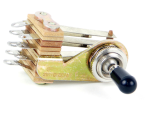Ro_S
New member
I'm new to swapping pick-ups and re-wiring. I'm modding one of my guitars with new pick-ups; and it be completely re-wired and have various new switches. I know what I want the switches to achieve. But I badly need advice in order to choose the correct type of switch to use for each of the purpose.
Please identify exactly what kind of toggle switch I need for each of the four purposes listed below:
(e.g. SPDT, DPDT; on/off/on, on/on/on, etc.)
#1. I'm having S/Duncan 'JB' humbucker pickup in the bridge position (call it say pickup 'A') I want to select between the following three different modes for pick-up 'A':
- full humbucker wired in series (normal mode);
- coil split (mode 2);
- both coils but wired in parallel (mode 3).
#2. I'll have two different types of single coil pick-ups situated in the neck position (call them say pickups C & D), adjacent to one another. I want to have following three options for them:
- pick-up 'C' on its own;
- pick-up 'D' on its own;
- both C & D together as a faux humbucker (wired in series).
Note: the bridge and neck pick-up positions will be selected via a 4-way blade style selector switch (like on a modified Telecaster switching arrangement), i.e. bridge only; both (series); both (parallel); and neck only.
#3. I'll have a single coil pick-up in the middle position (call it say pick-up 'B'). I want to have the following three switching options:
- pick-up 'B' only (call it 'red' circuit);
- circuit comprising pick-up A, C & D only (call it 'blue' circuit);
- both circuit 'red' and circuit 'blue' together (wired in series).
#4. My guitar will also have some piezo discs affixed to the body in the routing cavity. The piezo circuit will have its own passive tone and volume pots. The piezos and the magnetic pick-ups will all link up to a single, universal output jack. I want to wire the piezo circuit and the magnetic pickups' circuit so that I can have the following three switching options:
- piezos only (call it 'yellow' circuit)
- magnetic circuit [comprising circuits 'red' and 'blue'] (call it 'green' circuit)
- both circuit 'yellow' and circuit 'green' together (wired in series, or parallel?).
Does #1 need a DTDP on/on/on? Will a on/off/on do the same thing?
Does #2 need the same as #1?
What is the standard Gibson style 3-way pick-up selector switch? A on/on/on DTDP? Is that exactly what I've described, and need, in #3 and #4 above?
Many thanks!
Please identify exactly what kind of toggle switch I need for each of the four purposes listed below:
(e.g. SPDT, DPDT; on/off/on, on/on/on, etc.)
#1. I'm having S/Duncan 'JB' humbucker pickup in the bridge position (call it say pickup 'A') I want to select between the following three different modes for pick-up 'A':
- full humbucker wired in series (normal mode);
- coil split (mode 2);
- both coils but wired in parallel (mode 3).
#2. I'll have two different types of single coil pick-ups situated in the neck position (call them say pickups C & D), adjacent to one another. I want to have following three options for them:
- pick-up 'C' on its own;
- pick-up 'D' on its own;
- both C & D together as a faux humbucker (wired in series).
Note: the bridge and neck pick-up positions will be selected via a 4-way blade style selector switch (like on a modified Telecaster switching arrangement), i.e. bridge only; both (series); both (parallel); and neck only.
#3. I'll have a single coil pick-up in the middle position (call it say pick-up 'B'). I want to have the following three switching options:
- pick-up 'B' only (call it 'red' circuit);
- circuit comprising pick-up A, C & D only (call it 'blue' circuit);
- both circuit 'red' and circuit 'blue' together (wired in series).
#4. My guitar will also have some piezo discs affixed to the body in the routing cavity. The piezo circuit will have its own passive tone and volume pots. The piezos and the magnetic pick-ups will all link up to a single, universal output jack. I want to wire the piezo circuit and the magnetic pickups' circuit so that I can have the following three switching options:
- piezos only (call it 'yellow' circuit)
- magnetic circuit [comprising circuits 'red' and 'blue'] (call it 'green' circuit)
- both circuit 'yellow' and circuit 'green' together (wired in series, or parallel?).
Does #1 need a DTDP on/on/on? Will a on/off/on do the same thing?
Does #2 need the same as #1?
What is the standard Gibson style 3-way pick-up selector switch? A on/on/on DTDP? Is that exactly what I've described, and need, in #3 and #4 above?
Many thanks!


